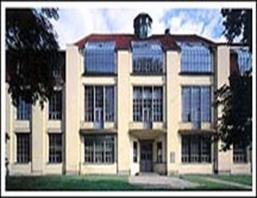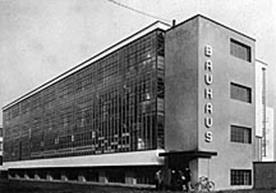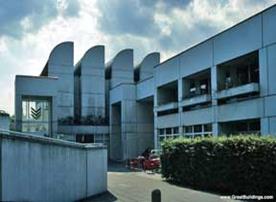Exercise 15. Read the text B. Notes: Pay attention to the pronunciation and the translation:
Notes: Pay attention to the pronunciation and the translation:
Gerhard Marcks; Lyonel Feininger; Johannes Itten; Paul Klee; Oskar Schlemmer; Wassily Kandinsky; .
1. employment policy – політика повної зайнятості
2. diversity - різноманітність
3. preliminary course – підготовчі курси
4. refuge - сховище
5. wall-painting – настінний живопис
6. dissemination - розповсюдження
7.
Text B The Three Locations of the Bauhaus
 |
Phase I Weimar, Germany
The high calibre artists Gropius appointed as masters at the Bauhaus Weimar included Gerhard Marcks, Lyonel Feininger, Johannes Itten, Paul Klee, Oskar Schlemmer, Wassily Kandinsky and László Moholy-Nagy. His employment policy was distinguished by its internationalism, cosmopolitanism and artistic diversity. During its existence in Weimar the Bauhaus became an important meeting place for the European avant-garde. In his manifesto and programme for the Staatliches Bauhaus Weimar, Walter Gropius called for a new beginning for building culture. Art should serve a social role, and there should no longer be a division between the crafts-based disciplines. Instead of academic theory, the Bauhaus relied on a pluralistic educational concept, on creative methods and the individual development of the students’ artistic talents. Talented young people could study at the Bauhaus Weimar irrespective of their educational background, gender or nationality.
The Bauhaus masters in Weimar developed a new type of teaching programme based on the preliminary course and practical training in the workshops. The ultimate goal of the educational programme was collaborative work on the “total work of art” to which all the Bauhaus workshops were to contribute. Despite a successful first exhibit the school was perceived as too liberal by the city of Weimar and was forced to leave for Dessau.

Phase 2 Dessau, GermanyThe Bauhaus was welcomed by the mayor of Dessau in 1925. Dessau was suitable location because its heavy industry could be used to produce Bauhaus products. A modern building complex was erected out of concrete, glass and steel. Gropius designed classrooms, dormitories and faculties housing that were grouped in a complete artistic community. The Bauhaus at Dessau included metal, furniture, weaving, typography, photography, wall-painting and sculpture workshops as well as departments for architecture, exhibition techniques and graphic design. The workshops utilized new techniques and materials of mass production in their creations. Among the many items it produced, was the first tubular chair. But Gropius and his successor, Hannes Meyer, were removed for their political views, and replaced byLudwig Mies van der Rohe.
 |
Phase 3 Berlin, GermanyAfter the Bauhaus in Dessau had been closed, Mies van der Rohe decided to continue the Bauhaus as a private art school in Berlin. Only seven other Bauhaus masters went along to Berlin that is why a smaller range of courses was offered. However, the Bauhaus did not have a bright future in Berlin. After the National Socialists had begun to attach more and more strings to the continuity of the Bauhaus, the pressure increased. It was assumed that the Bauhaus was a refuge for communists, that is why there was a house search in April 1933, leaving the rooms sealed and locked. Finally, the Bauhaus masters decided to shut the Bauhaus down in July 1933. After the dissolution of the Bauhaus in Berlin, a large number of those who taught and studied at the Bauhaus emigrated contributing greatly to the global dissemination of the Bauhaus concept.
In 1979, the Bauhaus Archive, designed by Gropius, was built in West Berlin. In 1997 the building was placed under historical protection and has been completely renovated under unified Germany.
The Bauhaus had a major impact on art and architecture trends in Western Europe, the United States, Canada and Israel in the decades following its demise. Tel Aviv in 2004 was named to the list of world heritage sites by the UN due to its abundance of Bauhaus architecture; it had some 4,000 Bauhaus buildings erected from 1933 on.
Exercise 16. Match the word combinations in column A with their equivalents in column B:
| A | B |
| 1. мистецька різноманітність 2.вихідні дані про освіту 3.використовувати нові технології та матеріали 4.масове виробництво 5.культура будівництва 6.дисципліни, засновані на ремеслі 7.творчі методи 8. обшук 9. перешкоджати 10.слугувати соціальній ролі | a)building culture b)to serve a social role c)creative methods d)crafts-based disciplines e) artistic diversity f)educational background g)mass production h)to attach strings j)house search k) to utilize new techniques and materials |
